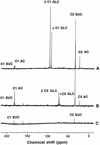13C and 1H nuclear magnetic resonance study of glycogen futile cycling in strains of the genus Fibrobacter
- PMID: 12033219
- PMCID: PMC124674
- DOI: 10.1128/AEM.64.1.74-81.1998
13C and 1H nuclear magnetic resonance study of glycogen futile cycling in strains of the genus Fibrobacter
Abstract
We investigated the carbon metabolism of three strains of Fibrobacter succinogenes and one strain of Fibrobacter intestinalis. The four strains produced the same amounts of the metabolites succinate, acetate, and formate in approximately the same ratio (3.7/1/0.3). The four strains similarly stored glycogen during all growth phases, and the glycogen-to-protein ratio was close to 0.6 during the exponential growth phase. 13C nuclear magnetic resonance (NMR) analysis of [1-13C]glucose utilization by resting cells of the four strains revealed a reversal of glycolysis at the triose phosphate level and the same metabolic pathways. Glycogen futile cycling was demonstrated by 13C NMR by following the simultaneous metabolism of labeled [13C]glycogen and exogenous unlabeled glucose. The isotopic dilutions of the CH2 of succinate and the CH3 of acetate when the resting cells were metabolizing [1-13C]glucose and unlabeled glycogen were precisely quantified by using 13C-filtered spin-echo difference 1H NMR spectroscopy. The measured isotopic dilutions were not the same for succinate and acetate; in the case of succinate, the dilutions reflected only the contribution of glycogen futile cycling, while in the case of acetate, another mechanism was also involved. Results obtained in complementary experiments are consistent with reversal of the succinate synthesis pathway. Our results indicated that for all of the strains, from 12 to 16% of the glucose entering the metabolic pathway originated from prestored glycogen. Although genetically diverse, the four Fibrobacter strains studied had very similar carbon metabolism characteristics.
Figures






Similar articles
-
Interactions between carbon and nitrogen metabolism in Fibrobacter succinogenes S85: a 1H and 13C nuclear magnetic resonance and enzymatic study.Appl Environ Microbiol. 1999 May;65(5):1941-8. doi: 10.1128/AEM.65.5.1941-1948.1999. Appl Environ Microbiol. 1999. PMID: 10223984 Free PMC article.
-
Futile cycling of glycogen in Fibrobacter succinogenes as shown by in situ 1H-NMR and 13C-NMR investigation.Eur J Biochem. 1992 Jul 1;207(1):155-62. doi: 10.1111/j.1432-1033.1992.tb17032.x. Eur J Biochem. 1992. PMID: 1628646
-
13C and 1H NMR study of cellulose metabolism by Fibrobacter succinogenes S85.J Biotechnol. 2000 Jan 28;77(1):37-47. doi: 10.1016/s0168-1656(99)00206-0. J Biotechnol. 2000. PMID: 10674213
-
In vivo 13C NMR study of glucose and cellobiose metabolism by four cellulolytic strains of the genus Fibrobacter.Biodegradation. 1998;9(6):451-61. doi: 10.1023/a:1008329814100. Biodegradation. 1998. PMID: 10335584
-
Simultaneous but differential metabolism of glucose and cellobiose in Fibrobacter succinogenes cells, studied by in vivo 13C-NMR.Can J Microbiol. 1996 Nov;42(11):1091-9. doi: 10.1139/m96-140. Can J Microbiol. 1996. PMID: 8941985
Cited by
-
Maximizing efficiency of rumen microbial protein production.Front Microbiol. 2015 May 15;6:465. doi: 10.3389/fmicb.2015.00465. eCollection 2015. Front Microbiol. 2015. PMID: 26029197 Free PMC article. Review.
-
Fiber-degrading systems of different strains of the genus Fibrobacter.Appl Environ Microbiol. 2004 Apr;70(4):2172-9. doi: 10.1128/AEM.70.4.2172-2179.2004. Appl Environ Microbiol. 2004. PMID: 15066810 Free PMC article.
-
Mtrr hypomorphic mutation alters liver morphology, metabolism and fuel storage in mice.Mol Genet Metab Rep. 2020 Mar 24;23:100580. doi: 10.1016/j.ymgmr.2020.100580. eCollection 2020 Jun. Mol Genet Metab Rep. 2020. PMID: 32257815 Free PMC article.
-
Enzymatic transformation of nonfood biomass to starch.Proc Natl Acad Sci U S A. 2013 Apr 30;110(18):7182-7. doi: 10.1073/pnas.1302420110. Epub 2013 Apr 15. Proc Natl Acad Sci U S A. 2013. PMID: 23589840 Free PMC article.
-
Genetic and isotope ratio mass spectrometric evidence for the occurrence of starch degradation and cycling in illuminated Arabidopsis leaves.PLoS One. 2017 Feb 2;12(2):e0171245. doi: 10.1371/journal.pone.0171245. eCollection 2017. PLoS One. 2017. PMID: 28152100 Free PMC article.
References
-
- Amann R I, Lin C, Key R, Montgomery L, Stahl D A. Diversity among Fibrobacter isolates: towards a phylogenetic classification. Syst Appl Microbiol. 1992;15:23–31.
-
- Bodenhausen G, Freeman R, Turner D L. Suppression of artifacts in two-dimensional-resolved spectroscopy. J Magn Reson. 1977;27:511–514.
-
- Bradford M M. A rapid and sensitive method for the quantitation of microgram quantities of protein utilizing the principle of protein-dye binding. Anal Biochem. 1976;72:248–254. - PubMed
-
- Bryant M P, Doetsch R N. A study of actively cellulolytic rod-shaped bacteria of the bovine rumen. J Dairy Sci. 1954;37:1176–1183.
Publication types
MeSH terms
Substances
LinkOut - more resources
Full Text Sources
Molecular Biology Databases

